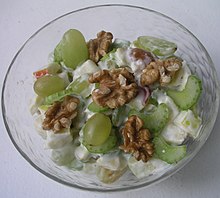For the Fawlty Towers episode, see Waldorf Salad (Fawlty Towers).
 A modern Waldorf salad with green grapes and whole walnuts, served in a glass bowl (2008) A modern Waldorf salad with green grapes and whole walnuts, served in a glass bowl (2008) | |
| Course | Appetizer |
|---|---|
| Place of origin | United States |
| Region or state | New York |
| Created by | Oscar Tschirky |
| Serving temperature | Chilled |
| Main ingredients | Apples, celery, mayonnaise, walnuts, grapes |
| Variations | Poultry, dried fruit (raisins, dates), yogurt dressing, zest of citrus, cauliflower, corn, blue cheese |
A Waldorf salad is a fruit and nut salad generally made of celery, fresh apples, walnuts, and grapes, dressed in mayonnaise, and traditionally served on a bed of lettuce as an appetizer or a light meal. The apples, celery, and grapes can all be green, which harmonizes the color palette of the dish.
History
Waldorf salad is named for the Waldorf-Astoria hotel in New York City, where it was first created for a charity ball given in honor of the St. Mary's Hospital for Children on March 13, 1896. The Waldorf-Astoria's maître d'hôtel, Oscar Tschirky, developed or inspired many of the hotel's signature dishes and is widely credited with creating the salad recipe. In 1896, the salad appeared in The Cook Book by "Oscar of the Waldorf".
The original recipe was just apples, celery, and mayonnaise. It did not contain nuts, but they had been added by the time the recipe appeared in The Rector Cook Book in 1928.
An American guest demanding a Waldorf salad featured prominently in a 1979 episode of the British sitcom Fawlty Towers. The salad is mentioned in the Cole Porter song "You're the Top".
Modern versions
Other ingredients such as chicken, turkey, and dried fruit (e.g., dates or raisins) are sometimes added. Updated versions of the salad sometimes change the dressing to a seasoned mayonnaise or a yogurt dressing. Modern Waldorf salad may also include the zest of oranges and/or lemons. Variations include a peanut butter and yogurt base, and one that replaces celery with cauliflower.
See also
- Fruit salad
- List of fruit dishes
- List of regional dishes of the United States
- List of salads
- Fawlty Towers
References
- Judith Weinraub (November 15, 2016). Salad: A Global History. Reaktion Books. pp. 89–. ISBN 978-1-78023-705-3.
- "Waldorf Salad". The English Kitchen. February 28, 2014. Retrieved September 2, 2020.
- Nan Lyons (March 1, 1990). New York City 1990. Bantam. ISBN 978-0-553-34845-3.
- Janet Clarkson (December 24, 2013). Food History Almanac: Over 1,300 Years of World Culinary History, Culture, and Social Influence. Rowman & Littlefield Publishers. pp. 245–. ISBN 978-1-4422-2715-6.
- "The History of Waldorf Salad". Kitchen Project. Retrieved September 20, 2007.
- Andrew F. Smith (November 26, 2013). New York City: A Food Biography. Rowman & Littlefield Publishers. pp. 155–. ISBN 978-1-4422-2713-2.
- "The History of Waldorf Salad". www.kitchenproject.com. Retrieved February 24, 2018.
- Andrew F. Smith (October 28, 2013). Food and Drink in American History: A "Full Course" Encyclopedia [3 Volumes]: A "Full Course" Encyclopedia. ABC-CLIO. pp. 774–. ISBN 978-1-61069-233-5.
- Gubler, Fritz; Glynn, Raewyn (2008). Great, grand & famous hotels. Great, Grand & Famous Hotels. p. 104. ISBN 978-0-9804667-0-6.
- "You're the Top (1934/2004) BioShock side-by-side comparison". YouTube. December 14, 2020.
- Andrew F. Smith (November 17, 2015). Savoring Gotham: A Food Lover's Companion to New York City. Oxford University Press. pp. 628–. ISBN 978-0-19-939702-0.